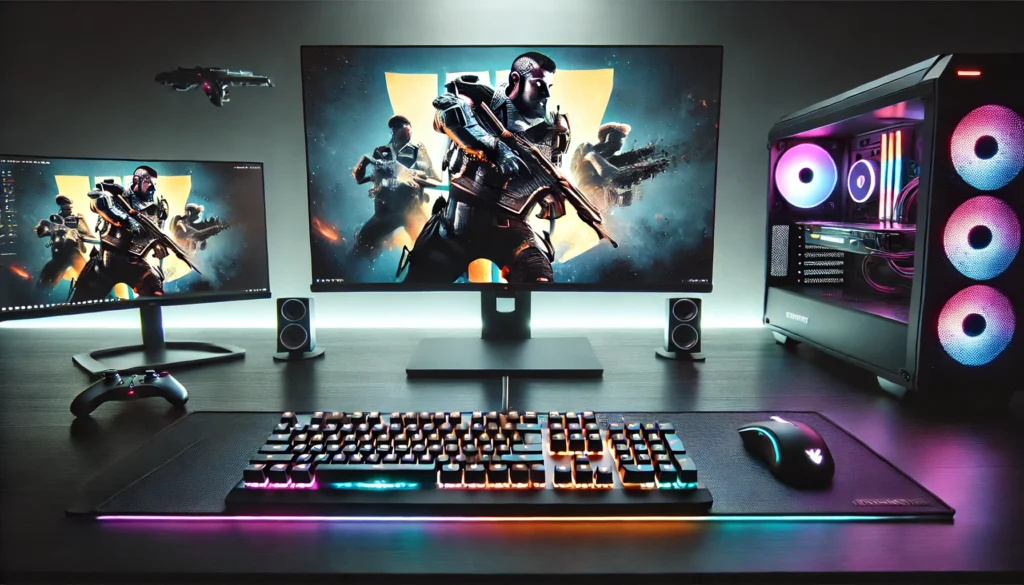Introduction
A gaming monitor is one of the most important peripherals for any PC gamer. The refresh rate and response time can significantly impact gameplay, especially in fast-paced titles like FPS and racing games. But with so many options available, how do you determine what’s best for you?
In this guide, we’ll break down refresh rates, response times, and other key features to help you choose the perfect gaming monitor.

1. What Is Refresh Rate and Why Does It Matter?
🔄 Refresh rate is measured in Hertz (Hz) and determines how many times per second the screen updates its image.
Common Refresh Rates:
- 60Hz – Standard for office monitors, not ideal for gaming.
- 120Hz – Decent for casual gaming.
- 144Hz – The sweet spot for most gamers.
- 165Hz – Slightly smoother than 144Hz, common in premium models.
- 240Hz+ – Best for competitive FPS and esports players.
💡 Higher refresh rates = smoother gameplay and reduced motion blur, making fast movements look more fluid.
2. What Is Response Time and Why Is It Important?
⏳ Response time (measured in milliseconds) refers to how quickly a pixel changes from one color to another.
Common Response Times:
- 5ms+ – Acceptable for casual gaming but may cause motion blur.
- 3ms-4ms – Decent for most gamers.
- 1ms-2ms – Ideal for competitive gaming.
- 0.5ms – Best for esports, reducing ghosting and motion blur.
💡 Lower response times = sharper, clearer images during fast movements.
3. How to Choose the Best Refresh Rate for Your Games
Not all games benefit equally from higher refresh rates. Here’s a guide based on game genre:
🎯 FPS & Competitive Games (CS:GO, Valorant, Call of Duty)
✅ 240Hz+ & 1ms (Best for fast reaction times and precision).
🏎 Racing & Fighting Games (Forza, Street Fighter)
✅ 165Hz or 240Hz & 1ms (Fast-paced games benefit from smoother motion).
🛡 RPGs & Adventure Games (The Witcher 3, Cyberpunk 2077)
✅ 144Hz & 2ms-4ms (Smoother gameplay without needing extreme response time).
🎮 Casual & Indie Games (Minecraft, Stardew Valley)
✅ 120Hz or 144Hz & 4ms (High refresh rates help but aren’t essential).
4. Refresh Rate vs. FPS: Do You Need a Powerful PC?
A high refresh rate monitor is only useful if your PC can output high FPS (frames per second).
🔹 144Hz monitor – Needs at least 144 FPS for best results.
🔹 240Hz monitor – Requires 240 FPS for full performance.
🔹 360Hz monitor – Demands extremely high-end hardware.
💡 If your GPU can’t handle high FPS, a high refresh rate monitor won’t provide full benefits.
5. G-Sync vs. FreeSync: Which One Should You Get?
Adaptive sync technologies help prevent screen tearing and stuttering.
🟩 G-Sync (NVIDIA users) – Works best with NVIDIA GPUs.
🟥 FreeSync (AMD users) – Works best with AMD GPUs.
💡 Some monitors support both technologies, making them more versatile.
6. Best Gaming Monitors by Category (2024)
| Category | Best Monitor | Refresh Rate | Response Time |
|---|---|---|---|
| Best Overall | ASUS ROG Swift PG259QN | 360Hz | 1ms |
| Best Budget | AOC 24G2 | 144Hz | 1ms |
| Best for Esports | BenQ Zowie XL2546K | 240Hz | 0.5ms |
| Best 4K Gaming | LG 27GN950-B | 144Hz | 1ms |
| Best Ultra-Wide | Samsung Odyssey G9 | 240Hz | 1ms |
Conclusion: What’s the Best Monitor for You?
The best refresh rate and response time depend on your gaming style and PC performance.
✔ For esports & FPS: Get a 240Hz+ monitor with 1ms or lower response time.
✔ For RPGs & general gaming: A 144Hz monitor with 2ms-4ms response time is great.
✔ For ultra-wide & 4K gaming: Prioritize high refresh rate and adaptive sync support.
Choosing the right monitor can boost your gaming performance and make every session more immersive! 🎮✨